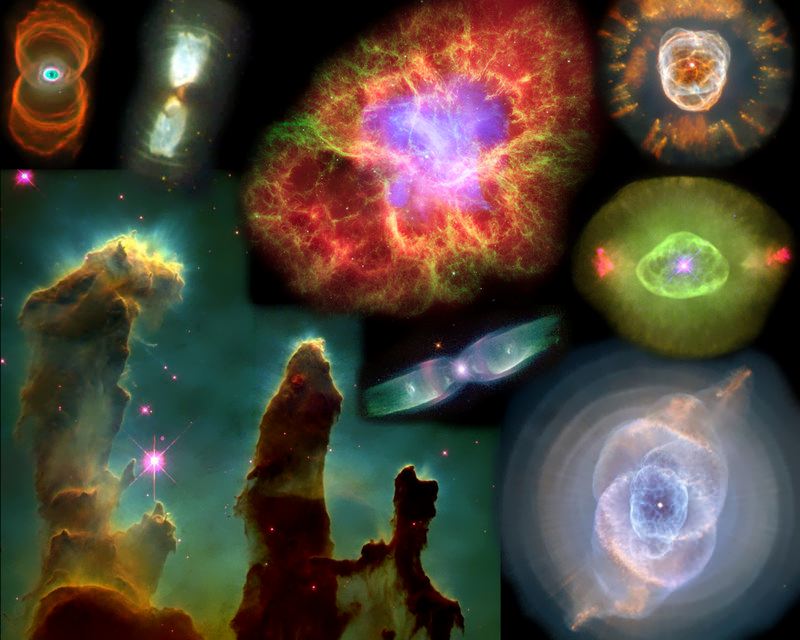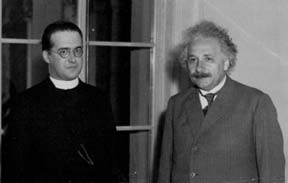We have been spoiled over recent years with first the Hubble Space Telescope (HST) and then the James Webb Space Telescope (JWST.) Both have opened our eyes on the Universe and made amazing discoveries. One subject that has received attention from both is the derivation of the Hubble Constant – a constant relating the velocity of remote galaxies and their distances. A recent paper announces that JWST has just validated the results of previous studies by the Hubble Space Telescope to accurately measure its value.
Continue reading “James Webb Confirms Hubble’s Calculation of Hubble’s Constant”Dark Matter Has a Firm Grip on These Galaxies

The elliptical galaxy NGC 1270 lies about 240 million light-years away. But it’s not alone. It’s part of the Perseus Cluster (Abell 426), the brightest X-ray object in the sky and one of the most massive objects in the Universe.
NGC 1270 plays a starring role in a new image from the Gemini North telescope. However, the image doesn’t show the dark matter that has a firm grip on the galaxy and the rest of the galaxies in the Perseus Cluster.
Continue reading “Dark Matter Has a Firm Grip on These Galaxies”How Hubble Unlocked the Universe
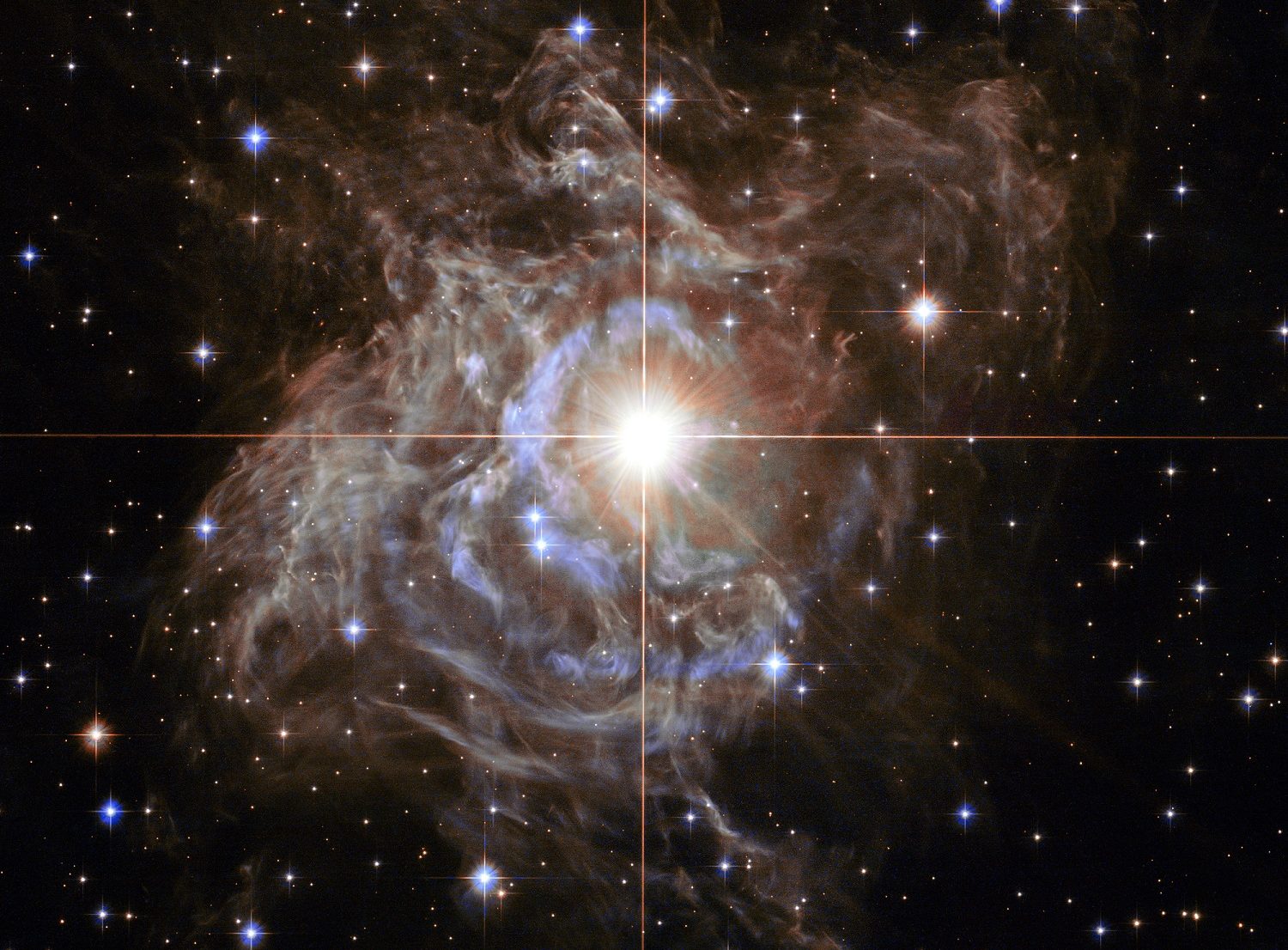
As engineers and technicians work diligently to diagnose and develop a solution (at best) or work around (at worst) the recent gyroscope issues in the Hubble Space Telescope, it gives us a moment to check in and reflect on some of its greatest feats of science. Don’t worry, that great observatory in the sky isn’t going anywhere anytime soon (as much as we would like an upgrade or replacement), so we can confidently look forward to many more years of astronomical greatness. But the Hubble has been running for almost three decades now; what has it contributed to the sum total of human knowledge of the universe?
Precise New Measurements From Hubble Confirm the Accelerating Expansion of the Universe. Still no Idea Why it’s Happening
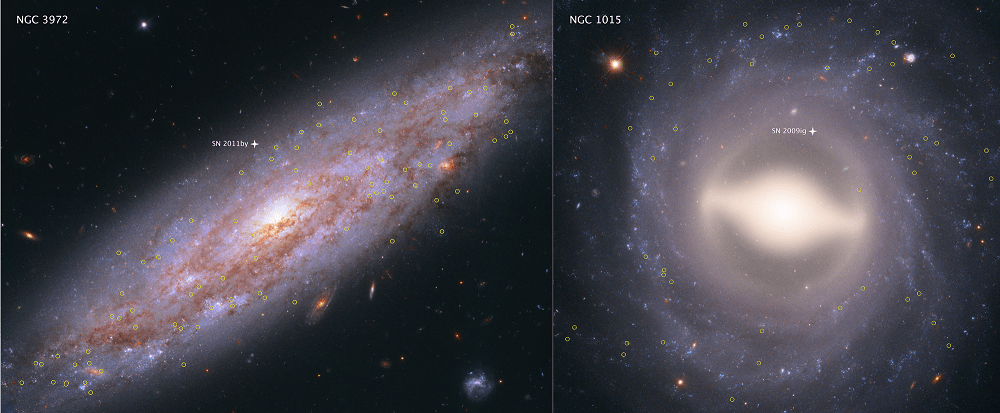
In the 1920s, Edwin Hubble made the groundbreaking revelation that the Universe was in a state of expansion. Originally predicted as a consequence of Einstein’s Theory of General Relativity, this confirmation led to what came to be known as Hubble’s Constant. In the ensuring decades, and thanks to the deployment of next-generation telescopes – like the aptly-named Hubble Space Telescope (HST) – scientists have been forced to revise this law.
In short, in the past few decades, the ability to see farther into space (and deeper into time) has allowed astronomers to make more accurate measurements about how rapidly the early Universe expanded. And thanks to a new survey performed using Hubble, an international team of astronomers has been able to conduct the most precise measurements of the expansion rate of the Universe to date.
This survey was conducted by the Supernova H0 for the Equation of State (SH0ES) team, an international group of astronomers that has been on a quest to refine the accuracy of the Hubble Constant since 2005. The group is led by Adam Reiss of the Space Telescope Science Institute (STScI) and Johns Hopkins University, and includes members from the American Museum of Natural History, the Neils Bohr Institute, the National Optical Astronomy Observatory, and many prestigious universities and research institutions.
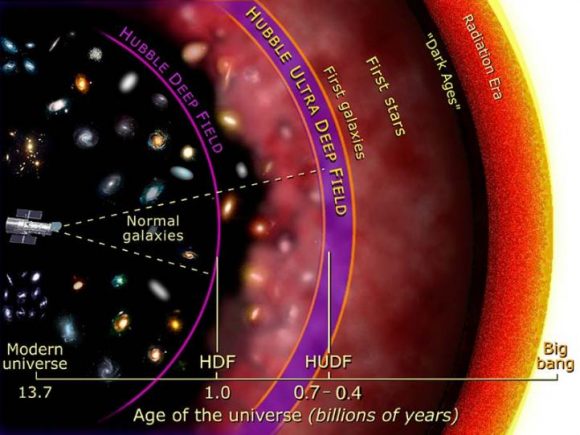
The study which describes their findings recently appeared in The Astrophysical Journal under the title “Type Ia Supernova Distances at Redshift >1.5 from the Hubble Space Telescope Multi-cycle Treasury Programs: The Early Expansion Rate“. For the sake of their study, and consistent with their long term goals, the team sought to construct a new and more accurate “distance ladder”.
This tool is how astronomers have traditionally measured distances in the Universe, which consists of relying on distance markers like Cepheid variables – pulsating stars whose distances can be inferred by comparing their intrinsic brightness with their apparent brightness. These measurements are then compared to the way light from distance galaxies is redshifted to determine how fast the space between galaxies is expanding.
From this, the Hubble Constant is derived. To build their distant ladder, Riess and his team conducted parallax measurements using Hubble’s Wide Field Camera 3 (WFC3) of eight newly-analyzed Cepheid variable stars in the Milky Way. These stars are about 10 times farther away than any studied previously – between 6,000 and 12,000 light-year from Earth – and pulsate at longer intervals.
To ensure accuracy that would account for the wobbles of these stars, the team also developed a new method where Hubble would measure a star’s position a thousand times a minute every six months for four years. The team then compared the brightness of these eight stars with more distant Cepheids to ensure that they could calculate the distances to other galaxies with more precision.
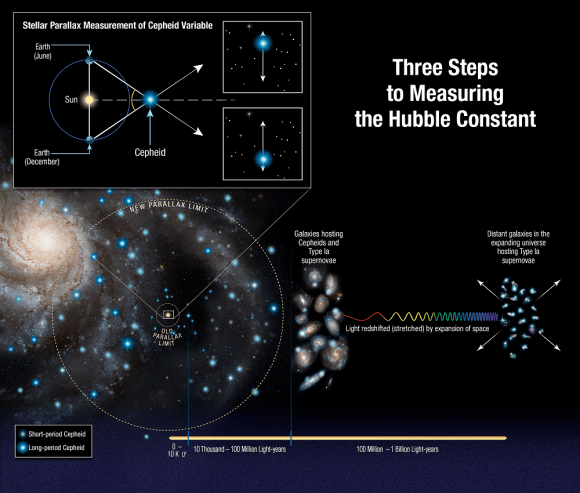
Using the new technique, Hubble was able to capture the change in position of these stars relative to others, which simplified things immensely. As Riess explained in a NASA press release:
“This method allows for repeated opportunities to measure the extremely tiny displacements due to parallax. You’re measuring the separation between two stars, not just in one place on the camera, but over and over thousands of times, reducing the errors in measurement.”
Compared to previous surveys, the team was able to extend the number of stars analyzed to distances up to 10 times farther. However, their results also contradicted those obtained by the European Space Agency’s (ESA) Planck satellite, which has been measuring the Cosmic Microwave Background (CMB) – the leftover radiation created by the Big Bang – since it was deployed in 2009.
By mapping the CMB, Planck has been able to trace the expansion of the cosmos during the early Universe – circa. 378,000 years after the Big Bang. Planck’s result predicted that the Hubble constant value should now be 67 kilometers per second per megaparsec (3.3 million light-years), and could be no higher than 69 kilometers per second per megaparsec.
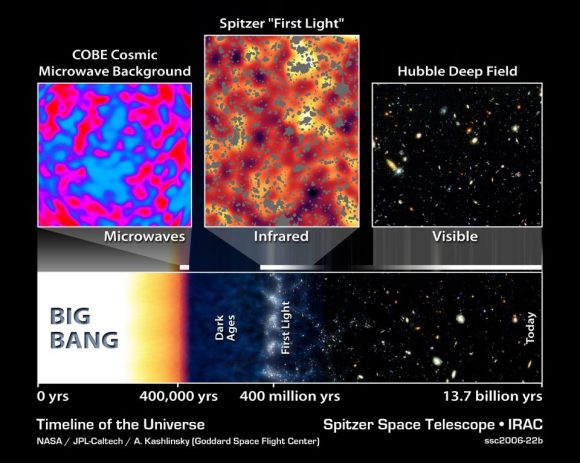
Based on their sruvey, Riess’s team obtained a value of 73 kilometers per second per megaparsec, a discrepancy of 9%. Essentially, their results indicate that galaxies are moving at a faster rate than that implied by observations of the early Universe. Because the Hubble data was so precise, astronomers cannot dismiss the gap between the two results as errors in any single measurement or method. As Reiss explained:
“The community is really grappling with understanding the meaning of this discrepancy… Both results have been tested multiple ways, so barring a series of unrelated mistakes. it is increasingly likely that this is not a bug but a feature of the universe.”
These latest results therefore suggest that some previously unknown force or some new physics might be at work in the Universe. In terms of explanations, Reiss and his team have offered three possibilities, all of which have to do with the 95% of the Universe that we cannot see (i.e. dark matter and dark energy). In 2011, Reiss and two other scientists were awarded the Nobel Prize in Physics for their 1998 discovery that the Universe was in an accelerated rate of expansion.
Consistent with that, they suggest that Dark Energy could be pushing galaxies apart with increasing strength. Another possibility is that there is an undiscovered subatomic particle out there that is similar to a neutrino, but interacts with normal matter by gravity instead of subatomic forces. These “sterile neutrinos” would travel at close to the speed of light and could collectively be known as “dark radiation”.
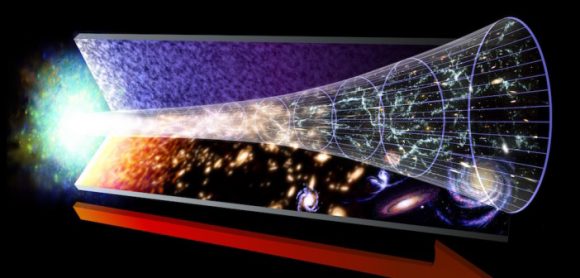
Any of these possibilities would mean that the contents of the early Universe were different, thus forcing a rethink of our cosmological models. At present, Riess and colleagues don’t have any answers, but plan to continue fine-tuning their measurements. So far, the SHoES team has decreased the uncertainty of the Hubble Constant to 2.3%.
This is in keeping with one of the central goals of the Hubble Space Telescope, which was to help reduce the uncertainty value in Hubble’s Constant, for which estimates once varied by a factor of 2.
So while this discrepancy opens the door to new and challenging questions, it also reduces our uncertainty substantially when it comes to measuring the Universe. Ultimately, this will improve our understanding of how the Universe evolved after it was created in a fiery cataclysm 13.8 billion years ago.
Further Reading: NASA, The Astrophysical Journal
Big Bang Theory: Evolution of Our Universe

How was our Universe created? How did it come to be the seemingly infinite place we know of today? And what will become of it, ages from now? These are the questions that have been puzzling philosophers and scholars since the beginning the time, and led to some pretty wild and interesting theories. Today, the consensus among scientists, astronomers and cosmologists is that the Universe as we know it was created in a massive explosion that not only created the majority of matter, but the physical laws that govern our ever-expanding cosmos. This is known as The Big Bang Theory.
For almost a century, the term has been bandied about by scholars and non-scholars alike. This should come as no surprise, seeing as how it is the most accepted theory of our origins. But what exactly does it mean? How was our Universe conceived in a massive explosion, what proof is there of this, and what does the theory say about the long-term projections for our Universe?
The basics of the Big Bang theory are fairly simple. In short, the Big Bang hypothesis states that all of the current and past matter in the Universe came into existence at the same time, roughly 13.8 billion years ago. At this time, all matter was compacted into a very small ball with infinite density and intense heat called a Singularity. Suddenly, the Singularity began expanding, and the universe as we know it began.
Continue reading “Big Bang Theory: Evolution of Our Universe”How Old is the Universe?
The Universe is vast bubble of space and time, expanding in volume. Run the clock backward and you get to a point where everything was compacted into a microscopic singularity of incomprehensible density. In a fraction of a second, it began expanding in volume, and it’s still continuing to do so today.
So how old is the Universe? How long has it been expanding for? How do we know? For a good long while, Astronomers assumed the Earth, and therefore the Universe was timeless. That it had always been here, and always would be.
In the 18th century, geologists started to gather evidence that maybe the Earth hadn’t been around forever. Perhaps it was only millions or billions of years old. Maybe the Sun too, or even… the Universe. Maybe there was a time when there was nothing? Then, suddenly, pop… Universe.
It’s the science of thermodynamics that gave us our first insight. Over vast lengths of time, everything moves towards entropy, or maximum disorder. Just like a hot coffee cools down, all temperatures want to average out. And if the Universe was infinite in age, everything should be the same temperature. There should be no stars, planets, or us.
The brilliant Belgian priest and astronomer, George Lemaitre, proposed that the Universe must be either expanding or contracting. At some point, he theorized, the Universe would have been an infinitesimal point – he called it the primeval atom. And it was Edwin Hubble, in 1929 who observed that distant galaxies are moving away from us in all directions, confirming Lemaitre’s theories. Our Universe is clearly expanding.
Which means that if you run the clock backwards, and it was smaller in the distant past. And if you go back far enough, there’s a moment in time when the Universe began. Which means it has an age. The next challenge… figuring out the Universe’s birthdate.
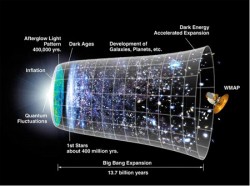
In 1958, the astronomer Allan Sandage used the expansion rate of the Universe, otherwise known as the Hubble Constant, to calculate how long it had probably been expanding. He came up with a figure of approximately 20 billion years. A more accurate estimation for the age of the Universe came with the discovery of the Cosmic Microwave Background Radiation; the afterglow of the Big Bang that we see in every direction we look.
Approximately 380,000 years after the Big Bang, our Universe had cooled to the point that protons and electrons could come together to form hydrogen atoms. At this point, it was a balmy 3000 Kelvin. Using this and by observing the background radiation, and how far the wavelengths of light have been stretched out by the expansion, astronomers were able to calculate how long it has been expanding for.
Initial estimates put the age of the Universe between 13 and 14 billion years old. But recent missions, like NASA’s WMAP mission and the European Planck Observatory have fine tuned that estimate with incredible accuracy. We now know the Universe is 13.8242 billion years, plus or minus a few million years.
We don’t know where it came from, or what caused it to come into being, but we know exactly how our Universe is. That’s a good start.
Are Our Textbooks Wrong? Astronomers Clash Over Hubble’s Legacy
“No scientific discovery is named after its discoverer,” – Stigler/Merton.
Edwin Hubble’s contributions to astronomy earned him the honor of having his name bestowed upon arguably the most famous space telescope (the Hubble Space Telescope, HST). Contributions that are often attributed to him include the discovery of the extragalactic scale (there exist countless other galaxies beyond the Milky Way), the expanding Universe (the Hubble constant), and a galaxy classification system (the Hubble Tuning Fork). However, certain astronomers are questioning Hubble’s pre-eminence in those topics, and if all the credit is warranted.
“[The above mentioned] discoveries … are well-known … and most astronomers would associate them solely with Edwin Hubble; yet this is a gross oversimplification. Astronomers and historians are beginning to revise that standard story and bring a more nuanced version to the public’s attention,” said NASA scientist Michael J. Way, who just published a new study entitled “Dismantling Hubble’s Legacy?”
Has history clouded our view of Hubble the man? Or are his contributions seminal to where we are today in astronomy?
Assigning credit for a discovery is not always straightforward, and Way 2013 notes, “How credit is awarded for a discovery is often a complex issue and should not be oversimplified – yet this happens time and again. Another well-known example in this field is the discovery of the Cosmic Microwave Background.” Indeed, controversy surrounds the discovery of the Universe’s accelerated expansion, which merely occurred in the late 1990s. Conversely, the discoveries attributed to Hubble transpired during the ~1920s.
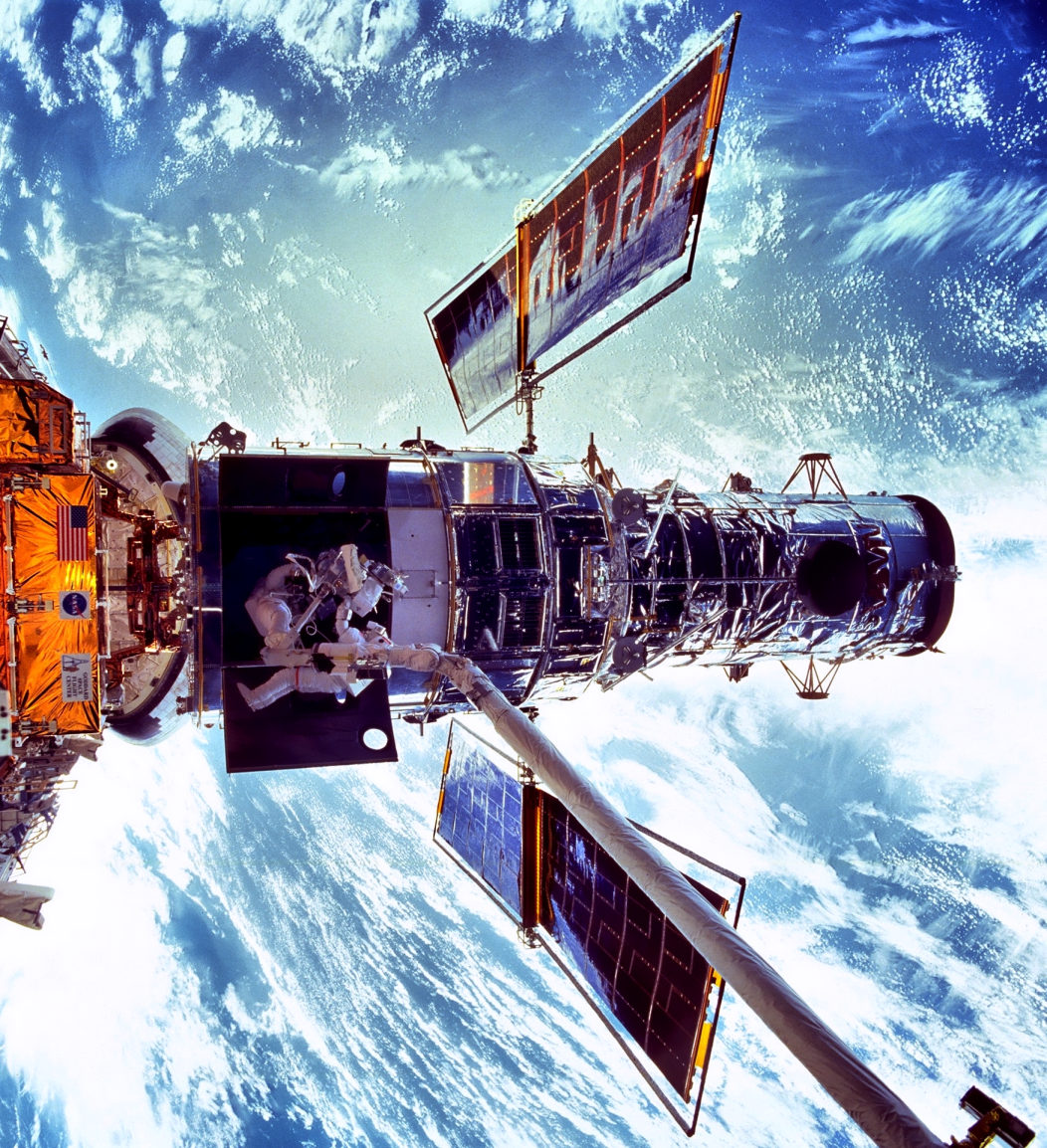
Prior to commencing this discussion, it’s emphasized that Hubble cannot defend his contribution since he died long ago (1889-1953). Moreover, we can certainly highlight the efforts of other individuals whose seminal contributions were overlooked without mitigating Hubble’s pertinence. The first topic discussed here is the discovery of the extragalactic scale. Prior to the 1920s it was unclear whether the Milky Way galaxy and the Universe were synonymous. In other words, was the Milky Way merely one among countless other galaxies?
Astronomers H. Shapley and H. Curtis argued the topic in the famed Island Universe debate (1920). Curtis believed in the extragalactic Universe, whereas Shapley took the opposing view (see also Trimble 1995 for a review). In the present author’s opinion, Hubble’s contributions helped end that debate a few years later and changed the course of astronomy, namely since he provided evidence of an extragalactic Universe using a distance indicator that was acknowledged as being reliable. Hubble used stars called Cepheid variables to help ascertain that M31 and NGC 6822 were more distant than the estimated size of the Milky Way, which in concert with their deduced size, implied they were galaxies. Incidentally, Hubble’s distances, and those of others, were not as reliable as believed (e.g., Fernie 1969, Peacock 2013). Peacock 2013 provides an interesting comparison between distance estimates cited by Hubble and Lundmark with present values, which reveals that both authors published distances that were flawed in some manner. Having said that, present-day estimates are themselves debated.
Hubble’s evidence helped convince even certain staunch opponents of the extragalactic interpretation such as Shapley, who upon receiving news from Hubble concerning his new findings remarked (1924), “Here is the letter that has destroyed my universe.” Way 2013 likewise notes that, “The issue [concerning the extragalactic scale] was effectively settled by two papers from Hubble in 1925 in which he derived distances from Cepheid variables found in M31 and M33 (Hubble 1925a) of 930,000 light years and in NGC 6822 (Hubble 1925c) of 700,000 light years.”
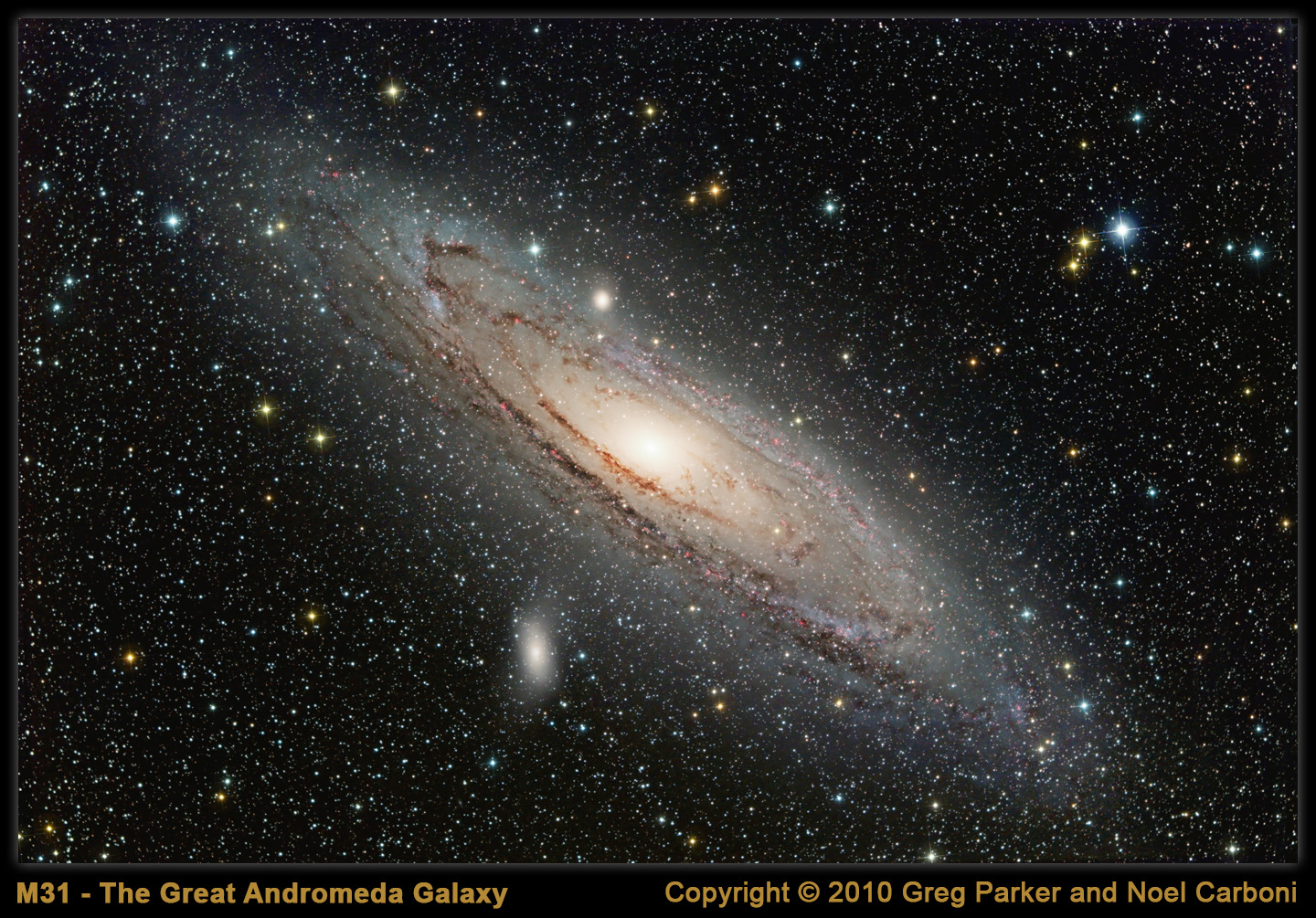
However, as table 1 from Way 2013 indicates (shown below), there were numerous astronomers who published distances that implied there were galaxies beyond the Milky Way. Astronomer Ian Steer, who helps maintain the NASA/IPAC Extragalactic Database of Redshift-Independent Distances (NED-D), has also compiled a list of 290 distances to galaxies published before 1930. Way 2013 added that, “Many important contributions to this story have been forgotten and most textbooks in astronomy today, if they discuss the “Island Universe” confirmation at all, bestow 100% of the credit on Hubble with scant attention to the earlier observations that clearly supported his measurements.”
Thus Hubble did not discover the extragalactic scale, but his work helped convince a broad array of astronomers of the Universe’s enormity. However, by comparison to present-day estimates, Hubble’s distances are too short owing partly to the existing Cepheid calibration he utilized (Fernie 1969, Peacock 2013 also notes that Hubble’s distances were flawed for other reasons). That offset permeated into certain determinations of the expansion rate of the Universe (the Hubble constant), making the estimate nearly an order of magnitude too large, and the implied age for the Universe too small.
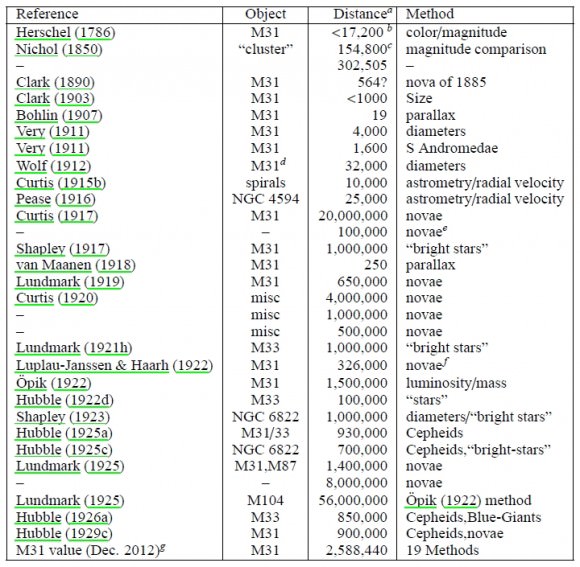
Hubble published his findings on the velocity-distance relation in 1929, under the unambiguous title, “A Relation Between Distance and Radial Velocity Among Extra-Galactic Nebulae”. Hubble 1929 states at the outset that other investigations have sought, “a correlation between apparent radial velocities and distances, but so far the results have not been convincing.” The key word being convincing, clearly a subjective term, but which Hubble believes is the principal impetus behind his new effort. In Lundmark 1924, where a velocity versus distance diagram is plotted for galaxies (see below), that author remarks that, “Plotting the radial velocities against these relative distances, we find that there may be a relation between the two quantities, although not a very definite one.” However, Hubble 1929 also makes reference to a study by Lundmark 1925, where Lundmark underscores that, “A rather definite correlation is shown between apparent dimensions and radial velocity, in the sense that the smaller and presumably more distant spirals have the higher space velocity.”
Hubble 1929 provides a velocity-distance diagram (featured below) and also notes that, “the data indicate a linear correlation between distances and velocities”. However, Hubble 1929 explicitly cautioned that, “New data to be expected in the near future may modify the significance of the present investigation, or, if confirmatory, will lead to a solution having many times the weight. For this reason it is thought premature to discuss in detail the obvious consequences of the present results … the linear relation found in the present discussion is a first approximation representing a restricted range in distance.” Hubble implied that additional effort was required to acquire observational data and place the relation on firm (convincing) footing, which would appear in Hubble and Humason 1931. Perhaps that may partly explain, in concert with the natural tendency of most humans to desire recognition and fame, why Hubble subsequently tried to retain credit for the establishment of the velocity-distance relation.
Hubble 1929 conveyed that he was aware of prior (but unconvincing to him) investigations on the topic of the velocity-distance relation. That is further confirmed by van den Bergh 2011, who cites the following pertinent quote recounted by Hubble’s assistant (Humason) for an oral history project, “The velocity-distance relationship started after one of the IAU meetings, I think it was in Holland [1928]. And Dr. Hubble came home rather excited about the fact that two or three scientists over there, astronomers, had suggested that the fainter the nebulae were, the more distant they were and the larger the red shifts would be. And he talked to me and asked if I would try and check that out.”
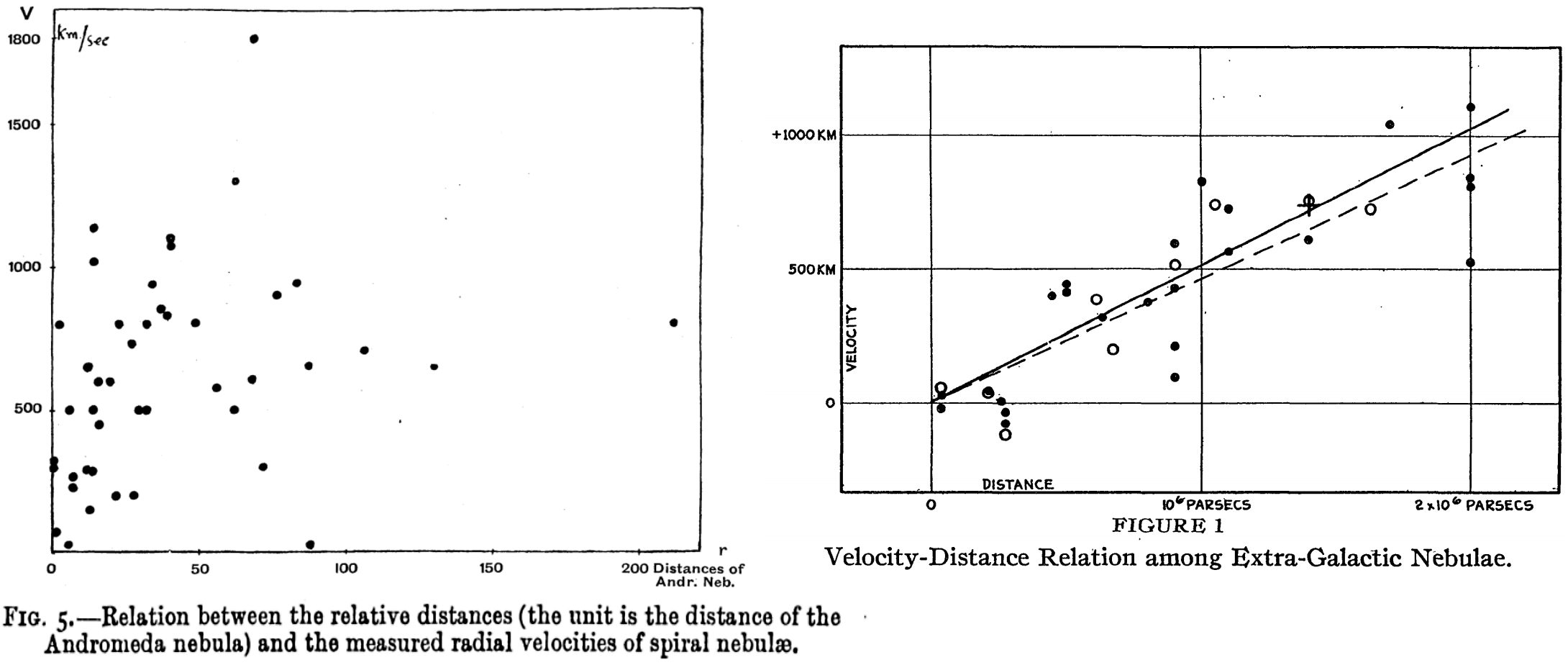
Hubble 1929 elaborated that, “The outstanding feature, however, is the possibility that the velocity-distance relation may represent the de Sitter effect, and hence that numerical data may be introduced into discussions of the general curvature of space.” de Sitter had proposed a model for the Universe whereby light is redshifted as it travels further from the emitting source. Hubble suspected that perhaps his findings may represent the de Sitter effect, however, Way 2013 notes that, “Thus far historians have unearthed no evidence that Hubble was searching for the clues to an expanding universe when he published his 1929 paper (Hubble 1929b).” Indeed, nearly two decades after the 1929 publication, Hubble 1947 remarks that better data may indicate that, “redshifts may not be due to an expanding universe, and much of the current speculation on the structure of the universe may require re-examination.” It is thus somewhat of a paradox that, in tandem with the other reasons outlined, Hubble is credited with discovering that the Universe is expanding.
The term redshift stems from the fact that when astronomers (e.g., V. Slipher) examined the spectra of certain galaxies, they noticed that although a particular spectral line should have appeared in the blue region of the spectrum (as measured in a laboratory): the line was actually shifted redward. Hubble 1947 explained that, “light-waves from distant nebulae [galaxies] seem to grow longer in proportion to the distance they have travelled It is as though the stations on your radio dial were all shifted toward the longer wavelengths in proportion to the distances of the stations. In the nebular [galaxy] spectra the stations (or lines) are shifted toward the red, and these redshifts vary directly with distance–an approximately linear relation. This interpretation lends itself directly to theories of an expanding universe. The interpretation is not universally accepted, but even the most cautious of us admit that redshifts are evidence either of an expanding universe or of some hitherto unknown principle of nature.”
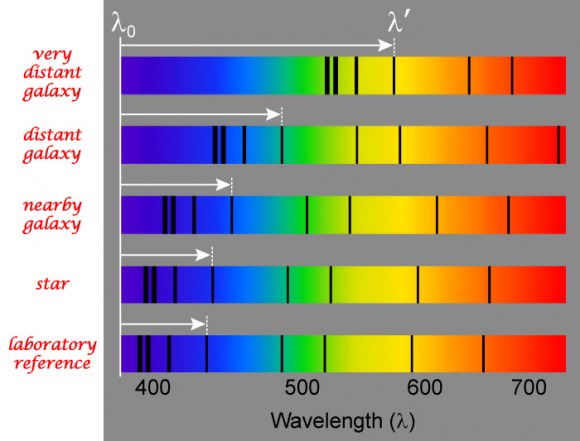
As noted above, Hubble was not the first to deduce a velocity-distance relation for galaxies, and Way 2013 notes that, “Lundmark (1924b): first distance vs. velocity plot for spiral nebulae [galaxies] …Georges Lemaitre (1927): derived a non–static solution to Einstein’s equations and coupled it to observations to reveal a linear distance vs. redshift relation with a slope of 670 or 575 km/s/Mpc (depending on how the data is grouped) …” Although Hubble was aware of Lundmark’s research, he and numerous other astronomers were likely unaware of the now famous 1927 Lemaitre study, which was published in an obscure journal (see Livio 2012 (Nature), and discussion therein). Steer 2013 notes that, “Lundmark’s [1924] distance estimates were consistent with a Hubble constant of 75 km/s/Mpc [which is close to recent estimates].” (see also the interpretation of Peacock 2013). Certain distances established by Lundmark appear close to present determinations (e.g., M31, see the table above).
So why was Hubble credited with discovering the expanding Universe? Way 2013 suggests that, “Hubble’s success in gaining credit for his … linear distance-velocity relation may be related to his verification of the Island Universe hypothesis –after the latter, his prominence as a major player in astronomy was affirmed. As pointed out by Merton (1968) credit for simultaneous (or nearly so) discoveries is usually given to eminent scientists over lesser-known ones.” Steer told Universe Today that, “Lundmark in his own words did not find a definite relation between redshift and distance, and there is no linear relation overplotted in his redshift-distance graph. Where Lundmark used a single unproven distance indicator (galaxy diameters), cross-checked by a single unproven distance to the Andromeda galaxy, Hubble used multiple indicators including one still in use (brightest stars), cross-checked with distances to multiple galaxies based on Cepheids variables stars.”
Concerning assigning credit for the discovery of the expansion of the Universe, Way 2013 concludes that, “Overall we find that Lemaitre was the first to seek and find a linear relation between distance and velocity in the context of an expanding universe, but that a number of other actors (e.g. Carl Wirtz, Ludwik Silberstein, Knut Lundmark, Edwin Hubble, Willem de Sitter) were looking for a relation that fit into the context of de Sitter’s [Universe] Model B world with its spurious radial velocities [the redshift].” A partial list of the various contributors highlighted by van den Bergh 2011 is provided below.
!["The history of the discovery of the expansion of the Universe may be summarized [above]", S. van den Bergh 2011. Image credit: S. van den Bergh/JRASC/arXiv.](https://www.universetoday.com/wp-content/uploads/2013/04/history-385x580.jpg)
In sum, the author’s personal opinion is that Hubble’s contributions to astronomy were seminal. Hubble helped convince astronomers of the extragalactic distance scale and that a relationship existed between the distance to a galaxy and its velocity, thus propelling the field and science forward. His extragalactic distances, albeit flawed, were also used to draw important conclusions (e.g., by Lemaitre 1927). However, it is likewise clear that other individuals are meritorious and deserve significant praise. The contributions of those scientists should be highlighted in parallel to Hubble’s research, and astronomy textbooks should be revised to emphasize those achievements A fuller account should be cited of the admirable achievements made by numerous astronomers working in synergy during the 1920s.
There are a diverse set of opinions on the topics discussed, and the reader should remain skeptical (of the present article and other interpretations), particularly since knowledge of the topic is evolving and more is yet to emerge. Two talks from the “Origins of the Expanding Universe: 1912-1932” conference are posted below (by H. Nussbaumer and M. Way), in addition to a talk by I. Steer from a separate event.
The Way 2013 findings will appear in the “Origins of the Expanding Universe: 1912-1932“, and a preprint is available on arXiv. The topic concerning the discovery of the galaxy classification system (i.e., the Hubble Tuning Fork diagram) was omitted from the present discussion, but is discussed by Way 2013. The interested reader desiring further information will find the following works pertinent, and there were numerous important astronomers omitted from the present discussion (e.g., A. Friedmann): Way and Nussbaumer 2011, van den Bergh 2011, Livio 2012, Steer 2011, Steer 2012, Peacock 2013, Lundmark 1924, Lundmark 1925, Hubble 1925, Hubble 1929, Hubble and Humason 1931, Hubble 1947; for discussion on the famed Island Universe debate see also Trimble 1995; Steer’s 290 distances to galaxies published before 1930 are available through the NASA/IPAC Extragalactic Database of Redshift-Independent Distances (NED-D); for information concerning the accusations levelled at Hubble see Livio 2012 (Nature); for discussion concerning Cepheids and problems that plagued their use as distance indicators see Fernie 1969; lastly, the reader is encouraged to peruse Hubble’s articles which are available via NASA/ADS.
The Expanding Universe – Credit To Hubble Or Lemaitre?
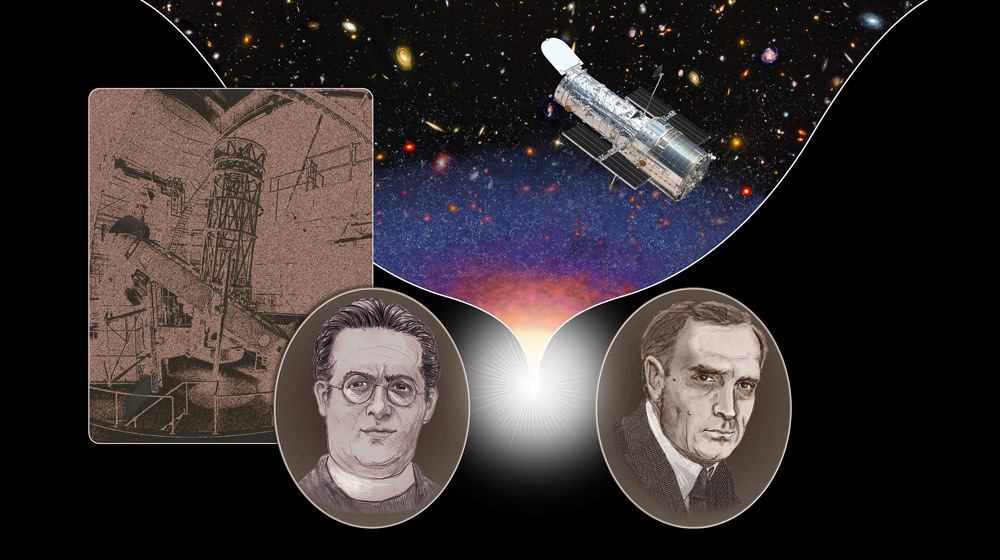
[/caption]
Perhaps one of the greatest astronomical discoveries of the 20th century may have gone down in the history books as credited to the wrong person. Now known as the Hubble Constant, the theory of an expanding Universe was first speculated by Belgian priest and cosmologist, Father Georges Lemaitre. How did this oversight occur? It may very well be the hand of the man himself who was unpretentious enough to pass on his findings.
According to the the November 10th issue of the journal Nature, astrophysicist Mario Livio of the Space Telescope Science Institute is calling for closure about a conspiracy theory of who should be properly credited for the discovery of the expansion theory. For almost a hundred years we’ve been led to believe American astronomer Edwin P. Hubble was the man who explained the universal expansion in 1929 – although he never won a Nobel prize for his work. His findings were based on the achievements of Vesto Slipher, who – through the use of redshift – calculated recessional velocities and paired them with distances to the same galaxies as Hubble’s work. This led Hubble to demonstrate that the further away a galaxy was, the faster it would recede… the Hubble Constant.
However, two years before Hubble published his work, a quiet man called Georges Lemaitre published the same conclusions based on Slipher’s same redshift data and Hubble’s calculated distances.
How did this happen and why didn’t Father Lemaitre get credit? According to news release, it may have been because the original paper was published in French, in a rather obscure Belgian science journal called the Annales de la Societe Scientifique de Bruxelles (Annals of the Brussels Scientific Society). Chances are, we never would have known except for a later translation which was published in the Monthly Notices of the Royal Astronomical Society in 1931… a paper which just “left out” Lemaitre’s 1927 calculations! Of course, there were people who knew these passages had been omitted since 1984 and the ensuing debate accused not only the editors of the Monthly Notices, but Hubble as well.
However, before any accusations can be made, let it be noted that astrophysicist Mario Livio combed through an exhaustive archive of hundreds of letters to the Royal Astronomical Society and the RAS meeting minutes – as well as Father Lemaitre’s Archive. What he found was the good Father had simply omitted the passages himself when he translated the papers to English. In one of two “smoking-gun letters” uncovered by Livio, Lemaitre wrote to the editors: “I did not find advisable to reprint the provisional discussion of radial velocities which is clearly of no actual interest, and also the geometrical note, which could be replaced by a small bibliography of ancient and new papers on the subject.”
What is left for us to ponder is “why” Georges Lemaitre didn’t want to take credit for this discovery. Can there really be an altruistic scientist? One who puts the simple act of discovery above himself?
Livio concludes, “Lemaitre’s letter also provides an interesting insight into the scientific psychology of some of the scientists of the 1920s. Lemaitre was not at all obsessed with establishing priority for his original discovery. Given that Hubble’s results had already been published in 1929, he saw no point in repeating his more tentative earlier findings again in 1931.”
Excuse me, folks… After having read the original news release, I think we should rename the Hubble Telescope to read the “Humble Telescope”.
Original Story Source: Hubblesite News Release.



